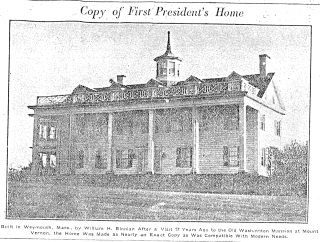Article: Copy of Washington Mansion Crowns High Hill

On Friday, February 20, 1925, the Christian Science Monitor of Boston published the following newspaper article praising the awe and splendor of the Emery Estate, then only 22 years old. A copy of the original article was provided to the Town of Weymouth by Lynn and Allan Emery of Beverly. Find a scanned image of the original article here.
Copy of Washington Mansion Crowns High Hill in Weymouth
Historic Association and Commanding Location of the Emery Home on King Oak Hill Recalls to Visitors the Charm of Original at Mount Vernon
Christian Science Monitor, Boston, February 20, 1925
Seventeen years ago, after William H. Binnian of Weymouth, Mass., had visited the old Washington mansion at Mount Vernon and had been thrilled, as have thousands of others, by the beauty and grandeur of the old home, not only for its historic associations but for its sightly location, he commissioned a Boston architect, Alfred L. Darrow, to plan a new home for him on King Oak Hill that should be as exact a copy of the famous house overlooking the Potomac River as possible.
Several years ago the property changed hands and is now owned by Allan C. Emery, Boston merchant. Several additions have been built on, in the form of small wings, since Mr. Emery acquired the house. Although comparatively little public mention has been made of the house, visitors from many parts of the country happening upon so apparently faithful a copy of the Washington shrine, have happily spread the report.
More and more, visitors are finding their way into the neighborhood to view this home, commanding an eminence as it does. Doubtless the holiday will attract many who, their thoughts gratefully turned to Washington and pleasurably remembering the charm of Mount Vernon, are glad of an opportunity to see a copy of it.
Commanding View
Mr. Darrow in an interview today told something of his experience in making the copy as nearly exact as possible, compatible with modern needs. Mr. Darrow explained:
For one thing the location, although it has pronounced and obvious differences from the original site, was a constant inspiration to the development t of the house. It commands an almost unparalleled view of all the region around.
The sea, a jagged shore line and an almost rural country meet in the view, and the precious grays and ashen greens and sapphire blues that are not too frequently brought into so happy a combination. On clear days it is possible to stand by the front steps or to look out of the lower windows and see some 40 miles along the coast. One may see as far away as the Gloucester shore and out to Thatcher’s Island.
In the evening, if it is clear, Mr. Emery has often been able to count as many as 21 torches, crimson and gold and white, glowing form the lighthouses up and down the coast. From the front door, through the ball which runs direct north and south, one looks squarely at the State House dome, Milton Hill house, the Custom House tower, very many of the favorite distances of sightseers, are visible from the lower rooms in the house.
Tower Faithful Copy
In appearance and several essential details the house is a faithful copy. We were able to make the tower practically perfectly so. The hall, running through the center of the house on the first floor, is exactly as the Mount Vernon hall is. The rooms all over the house, to be sure, are cut up quite differently, but that was an obviously necessary concession to modern usage. The house is neither quite as long nor quite as deep as the original.
Mount Vernon has, as I remember, eight portico columns. This house has only six. At Mount Vernon two colonnades run, from left and right, but it was impossible to make room or these here and they were left out. The barn, also, we copied exactly as to line, although we used wood whereas the Mount Vernon barn is of brick. Moreover our “barn” instantly became a garage.
Nevertheless it was a satisfying opportunity. It gives to the Weymouth house and to its neighborhood an indubitable flavor to have been modeled upon the essential lines of the Washington home. There is a certain “feel” to the house itself that sets it quite apart from the ordinary home built along good, conventional lines but borrowing no particular historic tradition from other splendid years.

